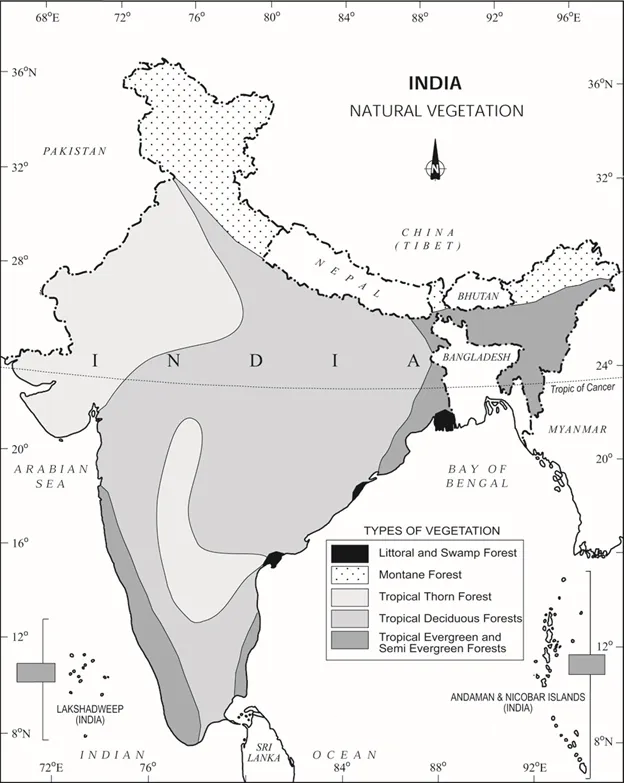Reserved Forest | 18 Feb 2022
For Prelims: Reserved Forest, Protected Forests, Village forest, Tropical Evergreen, Semi Evergreen Forests, Tropical Deciduous Forests, Montane Forests, Tropical Thorn forests, Swamp Forests
For Mains: Types of Forests in India and need to conserve Forests, Steps taken to preserve forests in India.
Why in News?
Recently, the Delhi government has notified forest land in two villages in South Delhi as ‘reserved forest’, which will give them legal status.
- It was notified under Section 20 (declaration of reserved forest) of Indian Forest Act, 1927.
What are the Different Types of Forests?
- Reserved Forests: Reserve forests are the most restricted forests and are constituted by the State Government on any forest land or wasteland which is the property of the Government.
- In reserved forests, local people are prohibited, unless specifically allowed by a Forest Officer in the course of the settlement.
- Protected Forests: The State Government is empowered to constitute any land other than reserved forests as protected forests over which the Government has proprietary rights and the power to issue rules regarding the use of such forests.
- This power has been used to establish State control over trees, whose timber, fruit or other non-wood products have revenue-raising potential.
- Village forest: Village forests are the one in which the State Government may assign to ‘any village community the rights of Government to or over any land which has been constituted a reserved forest’.
How are Forests Categorised Based on Rainfall in India?
- Tropical Evergreen and Semi Evergreen Forests:
- These forests are found in the western slope of the Western Ghats, hills of the northeastern region and the Andaman and Nicobar Islands.
- They are found in warm and humid areas with an annual precipitation of over 200 cm and mean annual temperature above 22oC.
- Tropical evergreen forests are well stratified, with layers closer to the ground and are covered with shrubs and creepers, with short structured trees followed by a tall variety of trees.
- In these forests, trees reach great heights up to 60 m or above. There is no definite time for trees to shed their leaves, flowering and fruition. As such these forests appear green all the year round.
- The semi evergreen forests are found in the less rainy parts of these regions. Such forests have a mixture of evergreen and moist deciduous trees. The undergrowing climbers provide an evergreen character to these forests.
- Tropical Deciduous Forests:
- These are the most widespread forests in India. They are also called the monsoon forests. They spread over regions which receive rainfall between 70-200 cm. On the basis of the availability of water, these forests are further divided into moist and dry deciduous.
- Montane Forests:
- In mountainous areas, the decrease in temperature with increasing altitude leads to a corresponding change in natural vegetation.
- Mountain forests can be classified into two types, the northern mountain forests and the southern mountain forests.
- Tropical Thorn forests:
- Tropical thorn forests occur in the areas which receive rainfall less than 50 cm. These consist of a variety of grasses and shrubs. It includes semi-arid areas of south west Punjab, Haryana, Rajasthan, Gujarat, Madhya Pradesh and Uttar Pradesh.
- In these forests, plants remain leafless for most part of the year and give an expression of scrub vegetation.
- Swamp Forests:
- They are found along the Andaman and Nicobar Islands and the delta area of the Ganga and the Brahmaputra.
- Other areas of significance are the Mahanadi, the Godavari and the Krishna deltas.
- Some of these forests are dense and impenetrable. Only a limited number of plants are found in these evergreen forests.
- They have roots that consist of soft tissue so that the plant can breathe in the water.
- It consists mainly of whistling pines, mangrove dates, palms, and bulletwood.
- They are found along the Andaman and Nicobar Islands and the delta area of the Ganga and the Brahmaputra.
What is the Status of Forest Cover in India?
- According to the India State of Forest Report-2021, the forest and tree cover in the country continues to increase with an additional cover of 1,540 square kilometres over the past two years.
- Madhya Pradesh has the largest forest cover in the country followed by Arunachal Pradesh, Chhattisgarh, Odisha and Maharashtra.
- In terms of forest cover as percentage of total geographical area, the top five States are Mizoram, Arunachal Pradesh, Meghalaya, Manipur and Nagaland.
- The states that have shown the highest increase in forest cover are Telangana (3.07%), Andhra Pradesh (2.22%) and Odisha (1.04%).
- Five states in the Northeast – Arunachal Pradesh, Manipur, Meghalaya, Mizoram and Nagaland have all shown loss in forest cover.

